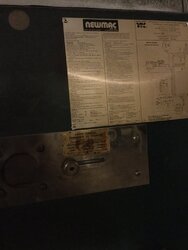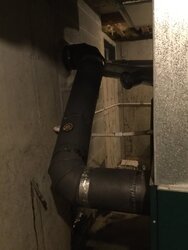


Hi all. I had a few questions and was hoping for some information. I'm fairly new to wood burning other than fireplaces. I recently purchased a home with a newmac add on wood furnace. The primary heat source is oil forced hot air. I really don't know much about the system at all. I've been doing as much research online as I can but haven't found many systems hooked up the way mine is. I hired a company to clean and inspect my chimney liner hoping to gain some information there but the person who came out didn't know anything about add on furnaces. I do know the old owner used the add on furnace on a regular basis.
The furnace is in the basement and the newmac has a stove pipe out the back which ties into the liner where the chimney probably runs close to 30 feet, maybe more(half the height of the basement wall, 2 full stories, an attic and a few feet above the roof line) the oil furnace pushes air out the top enters down at the bottom of the stove. Then ducts come out the top of the stove and feed the entire house. All air leaving the air handler(even A/C in the summertime) looks to pass through the stove. On the stove itself, there is a draft control knob above the door and another small sliding damper in the door. Many of the add on furnace setups I've seen have fans on the front of the stove with thermostats.
I have had one fire in the stove and it seemed to work very well as far as heating the house nice and evenly. I ran the the thermostat with heat off and fan on and it spread the heat throughout the house well. It actually got too warm and I ended up turning the fan off. Is this the typical setup or should they have more thermostatic control switching back to the primary heat source if need be. Some of the things I've read about to be on the lookout for were not running the stove hot enough and worrying about creosote buildup. Will my set up with the very tall chimney be prone to creosote buildup more so that with a shorter chimney? With no draft fan will I be more prone to my fires not being hot enough. I've also read about the newmac furnaces being prone to cracks in the heat exchangers. What is the best way for me to monitor this? Lastly what is the best way to monitor overfire being that this is now tied into my duct work. I have plenty or access to firewood and would like to use the furnace but want to make sure I am doing so in the safest manner possible being that I am new to the wood burning business. I will attach a few photos of my setup. I appreciate any bit of info I can get on add on wood burners and am excited to use mine.
Thanks.

